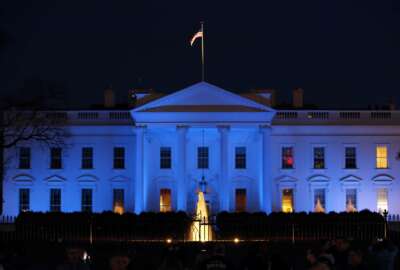
Hubbard Radio Washington DC, LLC. All rights reserved. This website is not intended for users located within the European Economic Area.
Hubbard Radio Washington DC, LLC. All rights reserved. This website is not intended for users located within the European Economic Area.
The Office of Information and Regulatory Affairs (OIRA) recently released its semi-annual regulatory agenda with 47 proposed and final Federal Acquisition Regul...
Nine states already allow for sports betting and 19 others have some sort of legislative action underway to make it legal, according to ESPN’s Oct. 30 sports betting tracker.
Betting on sport is so popular that the American Gambling Association estimates that all four major sports leagues would earn a collective $4.2 billion from legalized sports betting.
So what does this all have to do with federal government management issues?
Well, thanks for asking.
The Office of Management and Budget’s Office of Information and Regulatory Affairs (OIRA) recently released its semi-annual regulatory agenda and it got me thinking about the proposed and final Federal Acquisition Regulation (FAR) rules.
What are the chances of any of these rules getting past the finish line?
Well given the fact that over the last two years, the number of FAR rules that were either proposed or finalized was scarce, and there doesn’t seem to be any change on the horizon, I thought we might have some fun with the federal acquisition by putting some odds on how likely the most significant of the 36 proposed and nine final FAR rules would come to fruition.
The oddsmakers should keep in mind that George Washington University professor Bridget Dooling found the number of significant regulatory activity has fallen 74 percent since the Trump administration took office. During the first 18 months of the administration, agencies launched fewer than 250 big rules, compared to 807 in the first year of Barack Obama’s administration and more than 700 in George W. Bush’s first year.
I brought in my own version of a sports oddsmaker in Larry Allen, the president of Allen Federal Business partners and long-time federal acquisition observer and expert, to help me explain the odds we set:
1. Determination of fair and reasonable prices on orders under multiple award contracts
Odds: 5 to 1
Rationale: This one has a pretty good chance because several agencies already wrote deviations to the FAR that directs contracting officers to determine price reasonableness on their own. Allen said the next phase would be to bring this concept down to the task order level.
2. Use of Acquisition 360 to encourage vendor feedback
Odds: 25 to 1
Rationale: This proposed rule goes back to 2016 under the Obama administration so the likelihood of it getting through is not good. At the same time, Allen said it hasn’t gone away either in almost three years. “How would you regulate the feedback? There are a lot of things to get a 360 view of a transparent acquisition that doesn’t require a new rule, but changes in the processes and reminders to follow the rules on the books, including encouraging vendor feedback would be helpful,” he said. “I’m not sure there is a really strong regulatory case for it.”
3. Section 508-based standards in information and communication technology
Odds: 6 to 1
Rationale: The Access Board recently finalized updated Section 508 standards so this FAR update is almost an important formality. Allen said agencies still struggle to get Section 508 right in contracts so changing the FAR shouldn’t be too difficult.
4. Incremental funding of fixed-price contracting actions
Odds: 30 to 1
Rationale: This 2016 proposal isn’t likely to break through after almost three years. Allen said there has been a big push for much of the last decade to bring some uniformity to fixed price contracts as there already are regulations on the books for incremental funding for cost-plus type contracts. “This rule may end up being superseded by other happening with the Section 809 panel and the Defense Department going back to the drawing board on incremental funding for its contracts,” Allen said.
5. Definition of a “commercial” item
Odds: 15 to 1
Rationale: This one comes out of the 2018 Defense authorization bill where lawmakers wanted to expand and clarify what it means for agencies to buy commercial products and services. Allen said while this is an important proposal, there will be a lot of interest and that could slow down the process. This is why the odds of the council finalizing it in the next year are low.
6. Increasing task-order level competition
Odds: 7 to 2
Rationale: This is another one coming from the NDAA, but the most recent one signed into law in August. The proposed rule is a key piece to the General Services Administration’s goal of moving to unpriced schedules, which is why the odds are lower than most others. Allen said while the concept is limited to services contracts, which do account for a majority of federal acquisition spending, the broad goal is for agencies to get better pricing at the time of purchase. “It could create more burden on contracting officers, but it would mean they get more real time pricing based on scope of work,” he said.
7. Governmentwide and other interagency contracts
Odds: 10 to 1
Rationale: The goal of this rule would be to do away with requirements for DoD to need a written determination and finding before using non-Defense contracts. Allen said this requirement is a huge stumbling block for military services and Defense agencies. “Getting a D&F to use GSA’s Alliant or the schedules slows things down and requires more paperwork. Even when the services have an agreement to use Oasis or Alliant,” he said. “Section 875 is being read by industry as eliminating that requirement. It could streamline DoD acquisition and improve the use of non-DoD contracts across the govt.” At the same time, Allen said the odds are lower than some might think as the possibility of push back from DoD is real while the Pentagon waits for Section 809 panel recommendations and/or they want more analysis on how DoD is using non-Defense contracts.
1. Set-asides under multiple award contracts
Odds: 50 to 1
Rationale: The chances of this final rule finally cross the finish line remains long, particularly considering the council has been sitting on it since 2014. Allen said recent court decisions — the 2016 Kingdomware case requiring the Veterans Affairs Department to abide by the “rule of two” for small veteran-owned firms — has slowed down the progress of the proposed rule, causing the council to rethink whether they have to apply the “rule of two” to all task order contracts. “The odds are low and the rule may become irrelevant as we get Section 846 [e-commerce marketplace pilot] up and running,” he said. “It is more likely that the FAR case will be closed and a new one will be opened up that reflects all of these changes. This is not to say this isn’t important, but time may have overcome the current rule.”
2. Effective communication between government and industry
Odds: 3 to 1
Rationale: Of the 47 final and proposed rules, this one is the most likely to make it across home plate. Allen said this is one of those cases where OMB issued guidance, but until the FAR regulations change, there are a host of government acquisition people who are more conservative and need regulations to change. There is a lot of support across the government and industry acquisition communities for the use of tools such as reverse industry days, the “show, don’t tell me” approach to bids and other “innovations,” thus making this rule popular and an easy one to agree upon.
3. Prohibition on certain telecommunications and video surveillance services or equipment
Odds: 4 to 1
Rationale: This one also gets good odds because it’s part of the ongoing and increasingly strong focus on supply chain risk management. The FAR Council will implement the 2019 NDAA provision that prohibits agencies from buying products from China-based companies ZTE and Huawei Technologies. “Prohibiting agencies from buying from these companies because of the potential and real impact on the security of their supply chains is a big deal for industry and an even bigger deal for the government,” Allen said. “The rule is putting industry on notice saying technology from these companies are walled off to you whether you can save money or not. The biggest use of this is around the training on supply chain security.”
What are the chances of the Trump administration naming a permanent administrator in the Office of Federal Procurement Policy over the next 12 months?
Odds: 250 to 1
Rationale: It’s been more than two years since OFPP has had a permanent administrator and so far four candidates haven’t made it through the process for a variety of reasons. Allen said he doesn’t see any change on the horizon, either. “The administration has gone this long so they may be saying ‘why do we need one?’” he said. “And even if you named someone, it would be nine to 12 months before they got confirmed and then would only be in the position for nine to 12 months, so why measure for new curtains?”
Copyright © 2024 Federal News Network. All rights reserved. This website is not intended for users located within the European Economic Area.
Jason Miller is executive editor of Federal News Network and directs news coverage on the people, policy and programs of the federal government.
Follow @jmillerWFED



